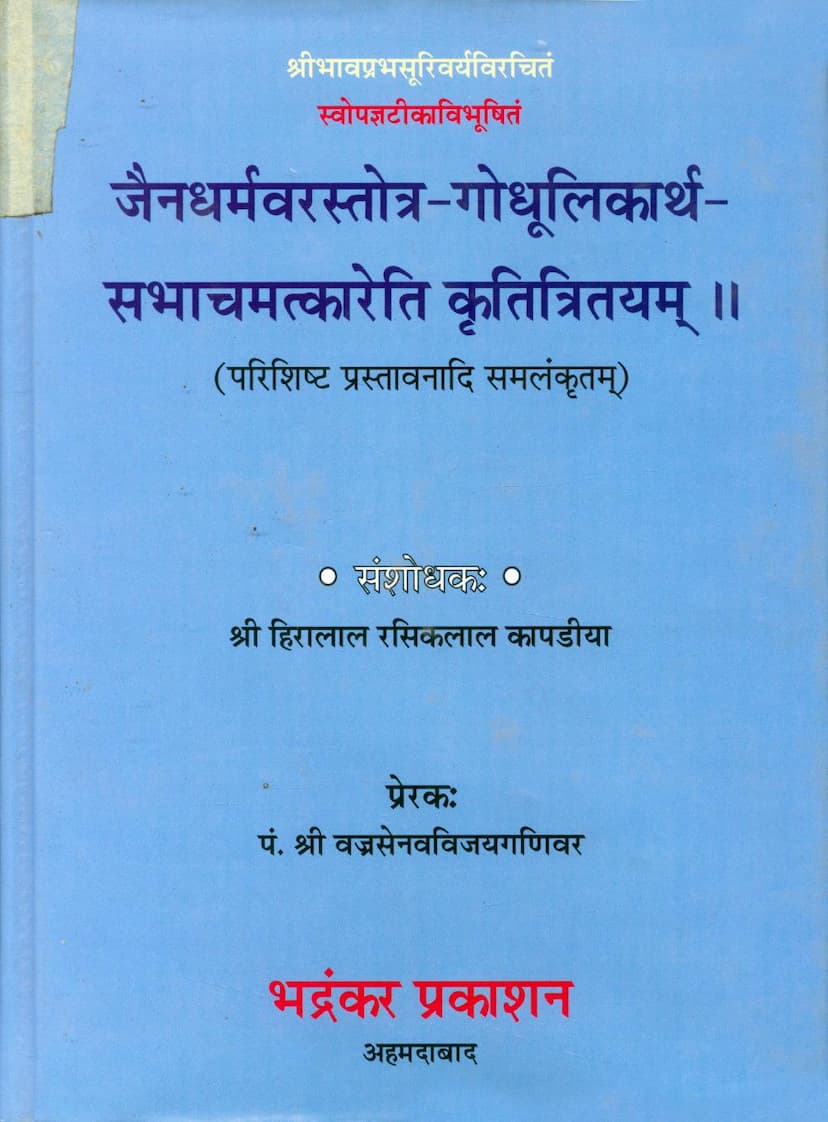Jaindharmvarstotra Godhulikarth Sabhachamatkareti Krutitritayam
Added to library: September 2, 2025

Summary
Here's a comprehensive summary of the Jain text "Jaindharmvarstotra Godhulikarth Sabhachamatkareti Krutitritayam" by Hiralal R Kapadia, based on the provided catalog link and pages:
Title: Jaindharmvarstotra Godhulikarth Sabhachamatkareti Krutitritayam (A Triad of Compositions: Jaindharmvarstotra, Godhulikarth, and Sabhachamatkar)
Author/Editor: Hiralal Rasikdas Kapadia
Publisher: Bhadrankar Prakashan, Ahmedabad
Publisher's Note: This publication brings together three main works by Shri Bhavaprabha Suri, along with two minor works. The publication is a re-issue, made possible through the inspiration and guidance of Pt. Shri Vajrasenvijay Ganivar. Financial support was provided by various Sangh trusts and patrons. The editor, Prof. Hiralal Kapadia, has provided extensive introductions and commentaries in Sanskrit and Gujarati.
Content Summary:
The book contains a collection of five Jain works:
-
Shri Jaindharmvarastotra: This is described as a poem that serves as a completion of the Kalyanmandirastotra. Its accompanying commentary, also by Bhavaprabha Suri, explains various stories and narratives in simple prose, relevant to the context. The text is noted for its use of various Sanskrit and Prakrit verses as evidence, alongside Gujarati and "Dingal" (possible reference to Old Gujarati). The editor highlights the author's deep understanding of Gujarati language, evidenced by the Gujarati passages and the Sanskritization of some Gujarati words.
-
Godhulikartha (also referred to as Gaphuli): This work expounds on the spiritual and worldly meanings of "Godhulika."
-
Sabha Chamatkara: This is a work composed in the Gujarati language.
-
Paripati Chaturdashakam: This composition is based on a Gatha (verse) that begins with "Chattari Atth Das Do Ya" (four, eight, ten, two). It interprets this Gatha in various ways, offering salutations to different Tirthas (sacred places). This section is attributed to Vinayavijay (Upa).
-
Chattari Atth Das Do Ya Vivaran Suchak Stavah: This is a hymn that provides various interpretations and explanations of the aforementioned Gatha, as expounded by Devendrasuri.
Key Aspects Highlighted by the Editor (Hiralal Kapadia):
- Nature of Jaindharmvarastotra: It is a "Padapurti" (completion) of the Kalyanmandirastotra, a common practice in Jain literature where poets complete verses or stotras of earlier works. The editor provides numerous examples of such "Padapurti" compositions from Jain literature, including completions of the Bhaktamara Stotra and Meghaduta.
- Linguistic Richness: The text incorporates Sanskrit, Prakrit, and Gujarati (including "Dingal" or Old Gujarati). The Gujarati passages are significant for understanding the author's knowledge of the language.
- Commentary (Swopajnya Vrutti): The presence of Bhavaprabha Suri's own commentary is a significant aspect, providing insights into the meaning and context of the stotra.
- Bhavaprabha Suri: The book includes extensive biographical information about Bhavaprabha Suri, compiled by the editor. It details his lineage (Ookesh Vansh, Vani Gotra), his pre-ascetic name (Bhavaratna), his attainment of the Suripadavi (title of Acharya) in 1772 Vikram Samvat. It also traces his guru lineage, starting from Shri Bhuvanaprabha Suri, through Vidyaprabha, Lalitaprabha, Vinayaprabha, Mahimaprabha, to Bhavaprabha. His extensive literary contributions across various subjects and languages (Sanskrit and Gujarati) are listed, with approximate dates.
Extensive Content within the Commentary:
The commentary on Jaindharmvarastotra is particularly detailed and covers a wide range of topics, often through allegorical stories and discussions of Jain philosophy and practices:
- Elaboration on Dharma: Discusses the nature, types, and importance of Dharma (righteous conduct), emphasizing its fourfold nature (Dana, Shila, Tap, Bhava).
- Spiritual Concepts: Explains concepts like Samvega (spiritual excitement), Nirveda (detachment), Shama (calmness), Anukampa (compassion), and Astikya (faith).
- Illustrative Narratives: The commentary is rich with illustrative stories, often complex and multi-layered, to explain spiritual principles. These include:
- The story of Dharmapriya, a merchant, and his encounters with infernal beings (Vyantara).
- The concept of the rarity of human birth and its opportunities, illustrated through ten "drishtantas" (examples/parables).
- The tale of Jagadu Shah, a merchant, who through righteous actions and charitable deeds, saved the people from famine and became a benefactor.
- The story of Chandanbala, a virtuous Jain woman, and her trials and eventual spiritual progress.
- The narrative of Harichand and Manoramā, illustrating the importance of virtuous conduct and devotion.
- The story of the Tirthankara Rishabhanatha and Bharat's devotion, leading to spiritual realization.
- Discussions on the nature of deities in other religions and their limitations compared to Jain Tirthankaras.
- Explanations of various Jain practices like Puja (worship), Dana (charity), Sheel (virtue), Tap (penance), and Bhavana (meditation).
- Detailed discussions on the purity of images (Bimba Shuddhi) and flowers used in worship (Pushpa Shuddhi).
- The significance of various types of Dana (charity) – Abhaya Dana (fearlessness), Mitra Dana (friendship), etc.
- The importance of the five Great Vows (Pancha Mahavratas) and the merits of following them.
- The exposition of the Panch Parameshthi (five supreme beings) and the power of the Namokar Mantra.
- The philosophical debate on the nature of reality and the critique of atheistic viewpoints.
- The exposition of the ten avatars of Vishnu and the critique of their mythological stories from a Jain perspective.
- The narrative of Bharat Chakravarti's spiritual journey and his eventual attainment of Kevala Jnana.
- The virtues of Shila (virtuous conduct) and its transformative power, illustrated through stories of pious women.
- The significance of the Sangha (community) and its role in spiritual progress.
- The detailed explanations of the "Chattari Atth Das Do Ya" Gatha, relating to the Tirthankaras in different regions (Jambudvipa, Bharatavarsha, Airavatavarsha, Mahavideha).
- The meaning and significance of "Godhulika" and its various interpretations, including spiritual ones.
Overall Significance:
This book is a valuable scholarly work that makes accessible important Jain religious and literary texts. It is highly beneficial for scholars of Jainism, Sanskrit, and Gujarati literature, offering deep insights into Jain philosophy, practices, history, and the rich tapestry of Jain devotional poetry. The meticulous work of Hiralal Kapadia in editing and annotating these works ensures their preservation and wider understanding.